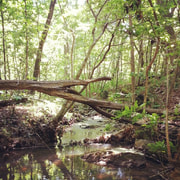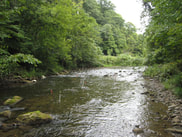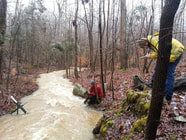The Zimmer Lab studies stream-groundwater interactions, water quality/quantity resource issues, hydrogeology, and hillslope hydrology. Below are some examples of current and past research initiatives in the Zimmer lab.

Coastal hydro-biogeochemistry
Coastal estuaries are the interface between uplands and the ocean; intercepting, transforming, and transporting pollutants on their course to the marine environment. Terrestrially-derived, nonpoint source nutrient pollution from rivers into coastal systems has been extensively characterized, but the contribution and fate of pollutants from groundwater is less understood. Our lab focuses on quantifying nitrogen fate and transport in shallow groundwater flowpaths at the aquatic-terrestrial interface in coastal watersheds. Our work is focused at the Elkhorn Slough National Research Reserve in Monterey Bay, CA.
Coastal estuaries are the interface between uplands and the ocean; intercepting, transforming, and transporting pollutants on their course to the marine environment. Terrestrially-derived, nonpoint source nutrient pollution from rivers into coastal systems has been extensively characterized, but the contribution and fate of pollutants from groundwater is less understood. Our lab focuses on quantifying nitrogen fate and transport in shallow groundwater flowpaths at the aquatic-terrestrial interface in coastal watersheds. Our work is focused at the Elkhorn Slough National Research Reserve in Monterey Bay, CA.

Streamflow generation and catchment water storage processes
Streamflow generation and catchment water storage processes are a well-studied aspect of catchment hydrology, however there is still a gap in our knowledge about how these processes contribute to channel network expansion, stream-aquifer interactions, and biogeochemical fluxes. Much of our research uses isotopic, hydrological, and biogeochemical methods to examine the major mechanisms for streamflow generation and the resulting hydroscape in ephemeral-to-perennial drainage networks. Our lab is currently conducting work at the UC Blue Oak Ranch Reserve in the Mt. Diablo Range in coastal central California.
For more details, check out these papers by the Zimmer group:
Zimmer MA and BL McGlynn. 2018. Lateral, vertical, and longitudinal source area connectivity drive runoff and carbon export across watershed scales. Water Resources Research, https://doi.org/10.1002/2017WR021718.
Zimmer MA and BL McGlynn. 2017. Time-lapse animation of hillslope groundwater dynamics details event-based and seasonal bidirectional stream-groundwater gradients. Hydrological Processes, DOI: 10.1002/hyp.11124.
Zimmer MA and BL McGlynn. 2017. Ephemeral and intermittent runoff generation processes in a low relief, highly weathered catchment. Water Resources Research, DOI: 10: 10.1002/2016WR019742.
Zimmer MA and BL McGlynn. 2017. Bidirectional stream-groundwater flow in response to ephemeral and intermittent streamflow and groundwater seasonality. Hydrological Processes, DOI: 10.1002/hyp.11301
Streamflow generation and catchment water storage processes are a well-studied aspect of catchment hydrology, however there is still a gap in our knowledge about how these processes contribute to channel network expansion, stream-aquifer interactions, and biogeochemical fluxes. Much of our research uses isotopic, hydrological, and biogeochemical methods to examine the major mechanisms for streamflow generation and the resulting hydroscape in ephemeral-to-perennial drainage networks. Our lab is currently conducting work at the UC Blue Oak Ranch Reserve in the Mt. Diablo Range in coastal central California.
For more details, check out these papers by the Zimmer group:
Zimmer MA and BL McGlynn. 2018. Lateral, vertical, and longitudinal source area connectivity drive runoff and carbon export across watershed scales. Water Resources Research, https://doi.org/10.1002/2017WR021718.
Zimmer MA and BL McGlynn. 2017. Time-lapse animation of hillslope groundwater dynamics details event-based and seasonal bidirectional stream-groundwater gradients. Hydrological Processes, DOI: 10.1002/hyp.11124.
Zimmer MA and BL McGlynn. 2017. Ephemeral and intermittent runoff generation processes in a low relief, highly weathered catchment. Water Resources Research, DOI: 10: 10.1002/2016WR019742.
Zimmer MA and BL McGlynn. 2017. Bidirectional stream-groundwater flow in response to ephemeral and intermittent streamflow and groundwater seasonality. Hydrological Processes, DOI: 10.1002/hyp.11301

Groundwater-surface water interactions
The body of literature on stream-groundwater interactions is rapidly growing, but little is known about the effects of changing flow conditions on the interactions between surface water and groundwater and the ecological and biogeochemical repercussions. Our work aims to address these knowledge gaps.
For more information, please download:
Research on storm event effects on GW-SW interactions:
Zimmer MA, Lautz LK. 2013. Temporal and spatial response of hyporheic zone geochemistry to a storm event. Hydrological Processes. DOI: 10.1002/hyp.9778.
Research on restoration effects on GW-SW interactions:
Zimmer MA, Lautz LK. 2015. Pre- and post- restoration assessment of stream-ground water interactions: impacts on hydrological and chemical heterogeneity in the hyporheic zone. Freshwater Science. DOI: 10.1086/679514. Invited Special Issue.
Smidt SJ, Cullin JA, Ward AS, Robinson J, Zimmer MA, Lautz LK, Endreny TA. 2014. A comparison of hyporheic extent at a stream restoration structure and natural feature. Groundwater. DOI:10.1111/gwat.12288.
The body of literature on stream-groundwater interactions is rapidly growing, but little is known about the effects of changing flow conditions on the interactions between surface water and groundwater and the ecological and biogeochemical repercussions. Our work aims to address these knowledge gaps.
For more information, please download:
Research on storm event effects on GW-SW interactions:
Zimmer MA, Lautz LK. 2013. Temporal and spatial response of hyporheic zone geochemistry to a storm event. Hydrological Processes. DOI: 10.1002/hyp.9778.
Research on restoration effects on GW-SW interactions:
Zimmer MA, Lautz LK. 2015. Pre- and post- restoration assessment of stream-ground water interactions: impacts on hydrological and chemical heterogeneity in the hyporheic zone. Freshwater Science. DOI: 10.1086/679514. Invited Special Issue.
Smidt SJ, Cullin JA, Ward AS, Robinson J, Zimmer MA, Lautz LK, Endreny TA. 2014. A comparison of hyporheic extent at a stream restoration structure and natural feature. Groundwater. DOI:10.1111/gwat.12288.

Resilience and disturbance on catchment hydrological function
Human-induced change can be seen across most landscapes, but it is still unclear how landscape change is and will impact the hydrologic cycle. I am specifically interested in how environmental change impacts the flowpaths of water and materials to and within streams, the memory of systems, the residence time of water in the subsurface, and the associated ecological and chemical signatures of the stream system.
Human-induced change can be seen across most landscapes, but it is still unclear how landscape change is and will impact the hydrologic cycle. I am specifically interested in how environmental change impacts the flowpaths of water and materials to and within streams, the memory of systems, the residence time of water in the subsurface, and the associated ecological and chemical signatures of the stream system.
